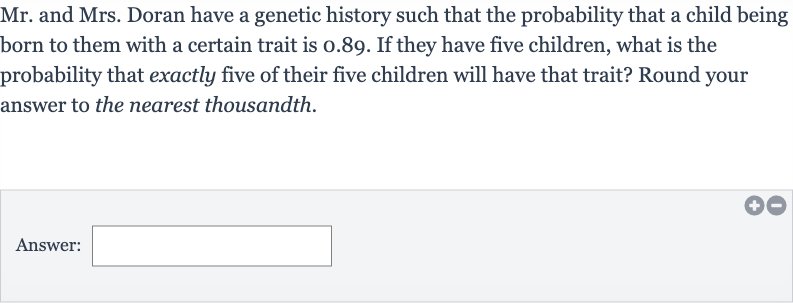AI tutor
Welcome to Bytelearn!
Let’s check out your problem:

Mr. and Mrs. Doran have a genetic history such that the probability that a child being born to them with a certain trait is . . If they have five children, what is the probability that exactly five of their five children will have that trait? Round your answer to the nearest thousandth.Answer:
Full solution
Q. Mr. and Mrs. Doran have a genetic history such that the probability that a child being born to them with a certain trait is . . If they have five children, what is the probability that exactly five of their five children will have that trait? Round your answer to the nearest thousandth.Answer:
- Identify values for formula: Identify the values of , , and for the binomial probability formula. represents the number of trials, which is the number of children, so . represents the number of successes, which is the number of children with the trait, so . represents the probability of success on a single trial, which is the probability of a child having the trait, so .
- Use binomial probability formula: Use the binomial probability formula: . Substitute , , and into the formula to calculate the probability that exactly five of the five children will have the trait. .
- Calculate : Calculate the value of . because the factorial of zero is and any number factorial divided by itself is .
- Simplify probability formula: Simplify the probability formula with the calculated values..Since is , and any number to the power of zero is , this term simplifies to .
- Calculate : Calculate ..
- Perform calculation for : Perform the calculation for ..
- Multiply values for probability: Multiply all the values together to find the probability...
- Round answer to nearest thousandth: Round the answer to the nearest thousandth. .
More problems from Find probabilities using the binomial distribution
QuestionGet tutor help
QuestionGet tutor help
QuestionGet tutor help
QuestionGet tutor help
QuestionGet tutor help
QuestionGet tutor help
QuestionGet tutor help
QuestionGet tutor help
QuestionGet tutor help
QuestionGet tutor help
